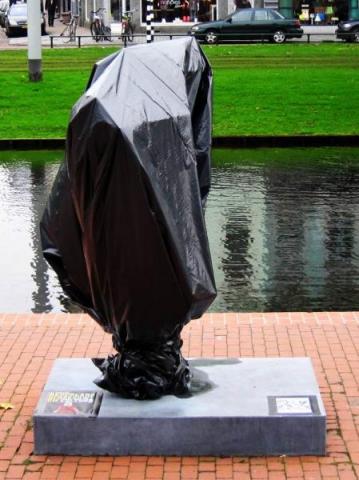The interrogation room

If you have seen one interrogation room from the inside, you have seen them all. They are nondescript spaces, with a desk, some chairs, and no windows. "So, what do you do for a living?" the policeman is asking us, as he places a cardboard box on the table, containing a small collection of car radios, with their cables all tangled up. There is no malice, nor threat in his question. He's just trying to make friendly conversation as we rummage about in the box, picking out the radio that had been stolen from our car the week before.
He is very interested to find out that we work as artists, and asks us what kind of things we make. His question provokes a slight hesitation, though, and we look at each other briefly. Opting for what we hope is a safe answer, we tell him we make video's. The policeman looks up, and he narrows his eyes. "What kind of video's?" he asks. We answer evasively, hoping we are not about to get dragged into a discussion on what can be considered art or not.
The value of art has always been a thankful topic for a bit of polemic, but ever since the newly elected right-wing Dutch government announced a 22% cut on arts and culture funding, this debate has reached a frenzied climax in the country where we spend a large part of the year. Cultural workers are staging protest demonstrations, denouncing the draconian measures as vindictive and resentful, aimed at destroying what their opponents have gleefully described as 'leftist hobbies'.
Those in support of the cuts are just as vocal, though, and reading through their comments on blogs and newspaper opinion pages is a helpful reminder of the sentiments that accompany an apparently widely felt antagonism towards art. Among the usual platitudes (conceptual art is a fraud, and the art world is an elitist incrowd), there was a text by a conservative politician that caught our attention, since it quoted the Spanish philosopher Ortega y Gasset to support its point that contemporary art had degenerated into self-serving ironical gestures:
“Modern art will always have the masses against it. It is is unpopular by essence; moreover, it is anti-popular. Any modern work of art will by itself automatically produce a curious sociological effect on its public. It divides it into two parts: one, a minority, consisting of people who approve of it; the other, a countless majority, hostile towards it. [...] The time is coming for society, from politics to art, to reorganize itself, as it should, into two ranks: that of eminent men and that of common men. All the malaise of Europe will lead towards this new and redemptive division and be healed by it. [...] For underneath all contemporary life throbs a profound and annoying injustice: the false assumption of equality among men." (José Ortega y Gasset. "La deshumanización del arte" 1925).
The indictment of elitism weighs heavily on our minds, as we contemplate what to tell the officer across the table from us. Yes, it's true that we have been engaged in our own flavour of anti-art, by mockingly dispensing with classical forms and traditions. And yes, we are guilty of subverting public funds to pursue our own agenda. But it should be said, in our defence, that we have been doing it out of idealism. Our goal was never the aesthetic aristocracy as envisioned by Ortega y Gasset. Instead, we have been trying to reconcile radical political views with new artistic forms, hoping to engender an artistic regimen of equality rather than privilege.
We worry that in spite of our good intentions, the policeman will think we are being pretentious and academic, so we keep our mouths shut. Fortunately, the man is oblivious to our petty complexes. In fact, he is smiling enthusiastically, as he leans over the table with an air of confidentiality. If we're any good with video, he says in a fatherly tone of voice, we should work for the police. They could use a little help with their public image, you see, and wouldn't this be a great way to earn some extra income?
Perhaps we should confess, at this point, that a few months ago we wrote about the idea that all art is essentially propaganda in service of the schizophrenic manifestations of power, in the article "At your service". Who would have figured that we would be confronted with our own statements inside the stuffy confines of a police interrogation room? It is as if a bright light is suddenly pointed towards us, and our faces are being scrutinized for signs of insincerity.
It is a disorienting situation, morally speaking, since the growing choir of voices fulminating against contemporary art is the same complaining about immigrants, and taxes, and a police that is too soft on crime. It dawns upon us that perhaps we are not being asked to make the police look friendlier, or less brutal at all. On the contrary. They may be looking for a new kind of public relations, based on old-fashioned images of authority, resolute strength, gloved hands firmly gripping rubber sticks, that sort of thing.
There's an ancient curse that says "May you live in interesting times" And it does seem that while we were waiting around for a revolution, we got caught up in the wrong one. Let's hope there is also a benefit to the recent surge of antipathy towards contemporary art, which is a trend not just restricted to the Netherlands. As an undercurrent of populist malcontent in society, it can throw deep-seated patterns of cultural division and exclusion into sharp relief. This could be the perfect moment for an art that re-examines its relation to power and symbolic violence, understood as those tacit forms of domination that we impose on each other, with our arsenal of every-day customs, prejudices and tastes.
Published in:
- Mugalari, el suplemento cultural del periódico Gara.
Recent comments